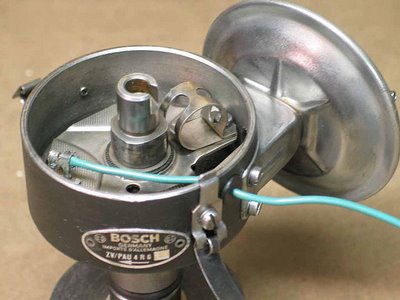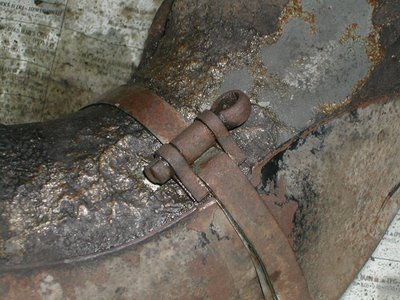I had to sideline the Ghia project for a while for some much needed roof repair and general waterproofing on the house (it doesn't rain very often in Southern California, but when it does...), but this weekend I was finally able to spend some time with the engine. A few weeks ago I was stopped cold by stripped threads in the case. I was trying to install the front half of the fan housing and the case threads for the left side mounting bolt decided to let go. I tried drilling and tapping the threads a little deeper and using a longer bolt but the few threads that were left wouldn't hold. I needed to find the strongest, most permanent solution since these bolts are notorious for coming loose over time anyway. Jim Adney on the
vwtype3.org list suggested using thread-locking helicoils. I wasn't familiar with the thread-locking version, but a quick Google search led me to them.

Locking helicoils aren't the easiest thing to find but they're a great thing to know about. They have an eccentric coil that holds the threads in tension, keeping the bolt from loosening. I was able to find 15mm M6 inserts, which are another half as long as the ones that are normally available.

Here's the right side one installed. I decided to do both for peace of mind, since the magnesium alloy case material is relatively soft. I was worried about drilling too deep on the right side -- the left side isn't a problem because if you drill too far it will break through to an area outside the case, but on the right side it will break through inside. Jim was kind enough to measure the case thickness on an old case in his shop, and on the right side it's only 20mm thick. A slight miscalculation would mean splitting the case to clean the shavings out, so I decided to drill only as far as absolutely necessary for the helicoil tap (17mm), and while it was a little nerve-wracking it all went according to plan. Now I can use 20mm bolts instead of the original 15mm, and since the helicoil threads are stainless steel the fan housing mounting will be stronger than what came from the factory.

I used the factory tool VW 177 to center the front half of the fan housing. The procedure is to position the centering tool, then rotate the fan housing counterclockwise until it stops at the split in the case, then tighten the two main bolts. This should be done with the crankcase breather stand and cooling tin screws loosened.

VW originally used shake-proof star washers with the fan housing bolts to keep them from loosening. They're a little funky but I figure VW knew what they were doing.

Here are the fan housing, fan, and pulley installed.

I used the factory 6V flywheel lock VW 215b while torquing the fan pulley bolt. I tightened the bolt to 36 ft. lbs. as recommended by Henry Elfrink's
Volkswagen Type 3 Technical Manual, but Russ Wolfe pointed out to me that it should actually be 90 or 100 ft. lbs. according to factory specs. John Muir's
How to Keep Your Volkswagen Alive also contains this error, so Type 3 engine builders beware. The Muir book is widely known to have errors, especially in the information about Type 3s, but it's a surprise to me that Elfrink got it wrong. He's usually pretty reliable. Thanks for the heads up, Russ!

The air intake housing is in place.

The generator and coil too. The intake manifold is placed loosely in position for the time being -- the manifold and carburetor are next on the agenda. It's starting to look like a Type 3 engine again.



















































